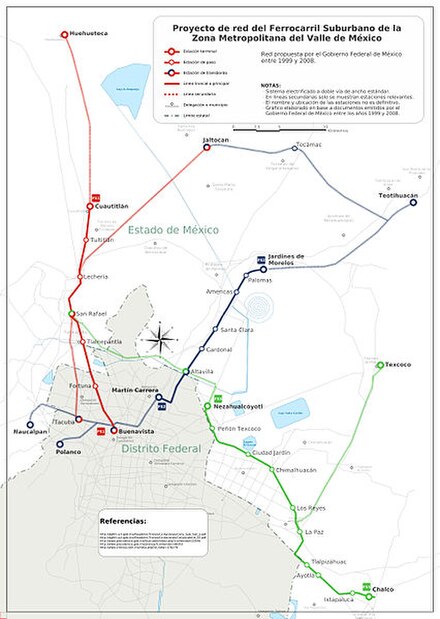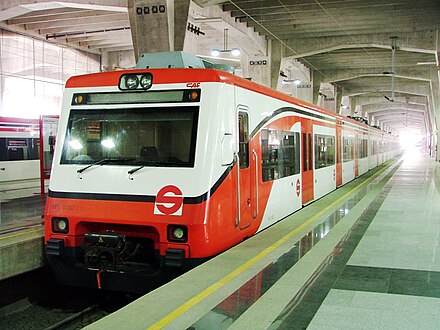Mexico State - most populous state of Mexico
Mexico State (Spanish: Estado de México), often referred to locally as Edomex (a contraction of the full Spanish name), is one of the federal entities of the country of the same name in Central Mexico, surrounding the Federal District and Mexico City on three sides.
Cities
- Toluca 📍 — capital of the state, known for its botanical gardens and many museums
- Aculco — has been designated a "Magic Town" for its traditional architecture full of alleys and houses with wide patios and corridors, buildings supported by columns and cobbled streets
- Amecameca 📍 — small town near the volcanoes Popocatepetl and Ixtaccihuatl
- Metepec 📍 — a touristy town known for its pottery
- Texcoco 📍 — preserves vestiges of the colonial style, highlighting religious buildings of the 17th century, and remains of structures from pre-Columbian times
- Tepotzotlán 📍 - charming small city on the Camino Real de Tierra Adentro, designated as one of Mexico's Pueblos Mágicos
- Tequixquiac — an important site for Catholic religious tourism and UFO fans
Other destinations
-
Teotihuacan 📍 - impressive pre-Columbian archaeological site with massive pyramids
-
Iztacchuatl-Popocateptl National Park 📍 - twin volcanoes east of Mexico City on the border with Puebla state
-
Nevado de Toluca National Park 📍 - snow-capped volcano near the state capital
Understand
This state is the most populous state (almost 17 million people in 2020) in the country and the most densely populated (720/km<sup>2</sup>). There are an abundance of activities around the state, but most are concentrated around the Mexico City metropolitan area and Toluca, the state capital.
The demonym used to refer to people and things from the state is mexiquense, distinct from mexicano ("Mexican"), which describes the people or things from the country as a whole.
Get in
Mexico State surrounds Mexico City on three sides, so travelers usually get into the state from outside the country or from more distant parts of the country through Mexico City. Domestic travelers from other Mexican cities and states can fly into Santa Lucia or Toluca.
By air
- Benito Juárez International Airport (usually known as Mexico City International) (IATA: MEX) is the main airport for Mexico City. It serves all Mexican commercial airlines and a wide range of foreign carriers with routes to the U.S., Canada, Europe, and Asia.
- Felipe Angeles International Airport (usually known as Santa Lucia Airport) (IATA: NLU) is a new commercial terminal opened in 2022, 48km north of Mexico City. It serves as an emerging hub airport for many Mexican carriers and handles some international flights to destinations in Latin America.
- Toluca International Airport (IATA: TLC) serves the state capital and has often served as a regional focus city for low-cost carriers. The airport is underutilized with infrastructure to handle far more traffic than it receives.
By bus
Mexico State is very easy to reach by bus with service to every larger population center by first-class bus and every small town by at least a second-class bus. See the articles for individual cities for details, or the country article for Mexico for names of larger bus companies.
Get around

 Bus and car are the most flexible ways to get around in Mexico State, though traffic is heavy and slow near Mexico City and in Toluca and larger cities. Train service is increasingly useful, but the network is limited in range and not always well integrated.
Bus and car are the most flexible ways to get around in Mexico State, though traffic is heavy and slow near Mexico City and in Toluca and larger cities. Train service is increasingly useful, but the network is limited in range and not always well integrated.
By train
The Ferrocarril Suburbano is a commuter rail system that connects downtown Mexico City with northern Mexico State municipalities. Service is provided on the Buenavista-Teotihuacan line (Blue), and the Buenavista-Cuauhtitlan line (Red). A third line (Green) connects Nezahualcyotl to Chalco. Communities served include Tultitlán, San Rafael, and Tlanepantla. Buses connect rail stations to nearby neighborhoods. Plans are underway to build a rail line connecting Ferrocarril Suburbano Line 1 with the Santa Lucia Airport (NLU).
Fares range from M$6.50 to M$15.50 (Jan 2023), depending on distance. You must buy a rechargable fare card to ride the train and fare cards for the Metro or the Tren Ligero do not work with Ferrocarril Suburbano (you have to buy a separate card). A rechargable card costs M$30, M$17 of which is an initial credit for fares. When you run out of money on your card, use the machines at rail stations to add funds.
The Tren Mexico City–Toluca is an inter-urban rail project under construction to connect the state capital with the nations capital. The 57-km rail line has been in the works since 2012 and is scheduled to open in 2023.
See
- The flowered gondolas in the floating gardens of Xochimilco are in the south of Mexico City (not Mexico State) but are still worth a trip.
- The Aqueduct of Padre Tembleque hydraulic system, a UNESCO World Heritage site (partially located in Hidalgo).
- The National Museum of the Viceroyalty is in Tepotzotlán, just outside Mexico City.
Do
- Zacango Ecological Park - large zoo in the town of Calimaya, (near Toluca), rhinos, giraffes, elephants, zebras and more than 170 other species.
Eat
Everything about Central Mexican cuisine is true of foot in Mexico State, though some dishes are more emblematic of the area than others.
Tlacoyos are similar to huaraches served in other states. It's essentially a thick, flat tortilla topped with stewed meats or vegetables. It can be folded in half and eaten like a big taco, but is more likely to be eaten like a slice of pizza. In Mexico State, tlacoyos are often made with blue corn meal, giving them a unique appearance.
Drink
Beer is the most popular drink in most of Mexico and in Mexico State, the most popular beers are from the Modelo brewery in Mexico City. A number of small craft breweries operate in many cities of the region. Pulque is also popular throughout Mexico State. Local craft breweries and pulquerias will be listed in the various destination (city) articles.
Stay safe
All of the usual advice to be vigilant applies in Mexico State, though the area is not one of the areas known for kidnappings or violent crime. It is generally safe to travel everywhere in the state with normal precautions.
Go next
- Cuernavaca - the city of eternal spring
- Hidalgo - many quaint colonial towns
